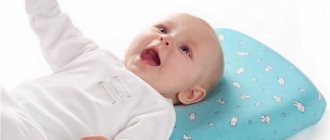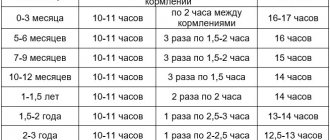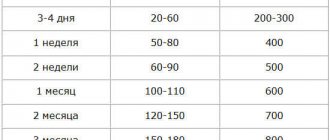Why can't a small child sleep on a pillow?
- Formation of the spine. Even the best and softest pillow can cause the spine to form incorrectly. Up to a year, the child spends most of the day in the crib and sleeps, and during this time the bones become stronger and grow together. Therefore, it is better to give preference to a flat surface. The same applies to the neck muscles.
- Allergic reaction. No matter what the filler is, it will still accumulate dust and other contaminants. It is not possible to wash the pillow every day, and the accumulation can lead to the development of a severe allergic reaction in the child.
- Foreign object. Firstly, during sleep, the pillow can move, get confused and frighten the baby. Secondly, sometimes children turn over on their stomachs in their sleep, and the pillow can block the airway.
Sometimes parents place a folded diaper under their newborn baby's head, but this is not necessary. If you choose a good mattress, your baby will feel very comfortable while sleeping and will grow and develop properly.
The dangers of pillows for a child's health
Some doctors say that a pillow is not needed until the age of three. Others are sure that from one year old the baby can be supported under his head. The fact is that during sleep the baby does not control its movements. He tosses and turns a lot and rolls from his back to his tummy, so the crib should be spacious. Turning face down and burying oneself in a soft product, the baby may suffocate in his sleep.
The second danger is the development of spinal curvature in children under one year of age. The bending of the skeleton at an early age is not yet formed. In children under 12 months, the ratio of head size to body size is 1:4. Lying on your back or side without lifting the neck, the spine is in a straight state. In an adult, the curvature of the cervical vertebrae is much more pronounced than in children, and sleeping without support under the head leads to disruption of blood flow to the brain.
The third danger is an allergic reaction to the filler. Latex is the most hypoallergenic material.
At what age can you use a pillow?
At what age does a baby sleep on a pillow? Some experts say that the first two or even three years should go without this bed attribute. Only then does the child’s life become conscious, the muscles and bones become strong enough not to be deformed under the influence of the pillow. But sometimes you need to put it in ahead of schedule:
- Torticollis. A congenital defect that requires correction. For this purpose, special pillows are used that fix the child's head in the correct position.
- Underdevelopment of the skull bones. In order for them to grow together, it is necessary to ensure that the baby does not turn his head and does not put stress on the problem area of the head.
- Frequent regurgitation. Pillows are used that make it easy to fix the child's position on his side.
All of these are high-quality orthopedic products that are purchased in certified centers and are even made to order. It should be placed only after consultation with a pediatrician, who will write down exactly what characteristics the product should have and when a child can sleep on a pillow made of other materials.
Does a one year old baby need a pillow?
Does a one-year-old baby need a pillow? Many adults cannot imagine how they can sleep without such an important attribute, but is it necessary for a baby?
Of course, adults find it much more comfortable to sleep on a pillow. This way our neck rests, the blood vessels are not squeezed - and oxygen flows unhindered to the brain all night long. In addition, a properly selected pillow is the key to sound sleep and excellent health. Otherwise, you are almost guaranteed a headache and back pain.
Does a one-year-old baby need a pillow?
Of course, you have already observed that during the first year of life the baby did not feel any discomfort in a crib without a pillow. When he grew up a little, it began to seem to you that he, like an adult, would be much more comfortable with this “sleepy” attribute.
A one-year-old child does not need it. And in general, it’s probably not worth raising the topic of pillows until the age of two. And from two years old it’s quite possible
In fact, at this age, children still weigh quite a bit and are not tall, so they don’t need a pillow . They get a full night's rest without unnecessary bedding. In addition, a pillow can even harm the baby: it increases the risk of SIDS or the child may roll out of bed if he does not have lateral support. Especially if the baby is mobile, and the pillow is too large and can be dangerous for him.
Experts do not recommend using a pillow for a toddler until he is at least two years old . And if the child is quite comfortable to continue sleeping without a pillow, the mother should not force him. Some parents recommend leaving the child without a pillow at least until the age of 4.
“A one-year-old child doesn’t need it. And in general, it’s probably not worth raising the topic of pillows until the age of two. And from two years old it is quite possible. The standard dimensions of a child’s pillow are 40*60 cm. Its thickness should be approximately equal to the width of the child’s shoulder,” says Dr. Evgeniy Komarovsky .
Read also: A child’s development depends on his sleep schedule
When you decide to make a purchase, you need to approach it with all responsibility. To start, make sure your pillow is small and flat to provide better neck support. Nowadays you can find many pillows on sale that are designed specifically for children.
A mother with the nickname gali4ka shares her experience : “I struggled for a long time with the question of choosing a pillow. Now everything is great - we sleep on a sheepskin pillow. She is soft, fluffy, and holds her head very well. We are 2.3. Plus, there are no mites or allergens in the wool, it doesn’t absorb odors, I’m happy.”
Read also: How to improve your child's sleep: 4 cozy ways
An inclined pillow is a good choice for small children . She perfectly holds the child on an inclined surface. The anatomical pillow, designed specifically for children, provides reliable neck support due to the indentation located in the center.
Even if you give preference to a regular square pillow , it is worth remembering that it should be low and elastic so that the baby's head and his torso are at the same height.
A child may well go without a pillow for up to two years or even longer, but he may be familiar from birth with the nursing pillow that his mother uses.
A pillow can be a great help in maintaining health, but it can also cause significant harm if you start using it too early. Therefore, before deciding whether a one-year-old child needs a pillow, listen to the advice of professionals and your heart.
Read also: Sweet dreams: what can disturb the baby’s peace
How to choose a pillow for a child?
- Size. The standard pillow size is 60x40 cm, but you need to take into account the child's age, height and weight. Before choosing one or another option, you should find out how much the height and width of the product should be.
- Form. The pillow should be as flat as possible so that the head does not rise high and does not disturb the child’s posture or cause discomfort or even pain.
- Filler. For a baby, comforter, holofiber or other hypoallergenic, safe, environmentally friendly material that breathes well and does not accumulate liquid is suitable. Sometimes buckwheat hulls are also used, but they rustle a lot, which can disturb the child.
- Napernnik. Orthopedic pillows most often come without it, but for ordinary pillows only options made from natural, high-quality materials are used. Any buttons, rivets or zippers are prohibited. The seams should be hidden and not put pressure on the child’s skin.
Some children may push out the pillow or change its position incorrectly during sleep. Therefore, many models have special fastening straps that allow you to securely fasten the product. But, if the child still tries to actively push it out, rolls over on his stomach and sleeps poorly, you need to think about whether a newborn baby needs a pillow, or whether he is comfortable just on the mattress.
Newborn pillow
Orthopedic pillow for a child
Usually, a pillow is not recommended for a newborn baby; it is advised to place a flannel diaper folded in four under the head. I agree with this, but there is a pillow suitable for a newborn.
It is called orthopedic, although it does not quite correspond to this name, but still, it can be used for a child from 0 to 6 months, and it is very convenient. The shape of the pillow resembles a butterfly, and in the middle it has a hole for the head. The filling of such a pillow is usually latex, the top is made of cotton.
While the child is small, the pillow is positioned as in the picture, then the child’s head will be in the hole, and the shoulders will rest against the “butterfly wings”; when the child grows up, the pillow will turn upside down - then again its lower edge will correspond to the width of the child’s shoulders.
When the child's head is on this pillow, there is no additional load on the child's cervical spine; on the contrary, the neck is slightly fixed in a position that is good for the child. This pillow helps prevent torticollis in children and helps reduce skull deformation in the first months of life if the baby prefers to sleep on one side.
It is very convenient to place it in the stroller; the child’s head remains on the pillow when the stroller moves. An orthopedic pillow is not sold in a pharmacy, but in children's stores. But the pillow has one drawback - you will have to sew the pillowcases yourself.
After 6 months, the child becomes active and slides off the pillow during sleep.
inclined pillow
Inclined pillow
Infants often have situations when it is necessary to create an elevated position of the baby's head during sleep: with frequent regurgitation, with a cold.
An inclined pillow works well for this purpose. Its height is 9-12 cm, its angle of inclination is 15 - 30°. The simplest version of this pillow can be placed on the crib as a pillow, or placed under the sheet or under the mattress.
There are larger options with a retaining belt; this pillow is more like a mattress. The filler is polyurethane and cannot cause allergies or suffocation.
Only the pillowcase can be washed. Recommended for children from 0 to 6 months. After 6 months, the child finds a comfortable position for himself and such a pillow loses its meaning.
pillow from 6 months to 2 years
Baby pillow “butterfly”
The debate about how many months or years of age a child needs neck support has been going on for a long time. Despite doctors' advice not to use a pillow before the age of 3, in some cases it is necessary. These include:
- congenital torticollis, which can be corrected in the first months of life;
- frequent regurgitation during sleep;
- deformation of the skull bones due to the habit of sleeping in one position (can be corrected with the help of an orthopedic product selected by a doctor).
Up to 6 months, a newborn is advised to place a diaper folded in four under the sheet in the neck area. You can replace this method with a butterfly-shaped product. The inside of the “butterfly” is latex, the outside is cotton fabric. Due to the non-standard shape, you will need to sew the pillowcase yourself. In the very first months of life, the “butterfly” should be placed with the wide side up. The narrow part should correspond to the size of the hanger, and the head should fit into the recess in the center of the product. When the child grows up, it can be turned over so that the width of the bottom again corresponds to the width of the shoulders.
Advice
A properly selected orthopedic product will prevent the development of torticollis and skull deformation.
When using an orthopedic butterfly pillow, there is virtually no risk of developing torticollis. The habit of sleeping in one position on the side is eradicated, the head is fixed in the correct position. If you notice that the skull is beginning to take on a flat shape on one side, do not hesitate to go to the doctor.











